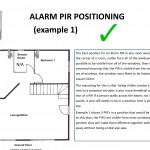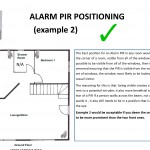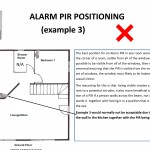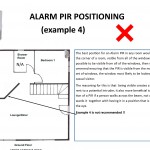How & Where would I install a Movement Sensor (PIR) whilst fitting an Alarm System?
If you have a home or building which is already pre-wired for an Alarm installation, then without a lot of potentially messy work, you are stuck with the position of the cables for the installation of the PIR, but hopefully the installer has positioned these correctly.
If you have , or you are considering to purchase a Wireless Alarm, then you can easily fit the PIR’s into the most suitable locations, if they are already fitted they are very easy to move.
What Are They?
For customers who are new to Alarm Systems, PIR stands for ‘Passive Infra-red Detector’.
A PIR will detect changes in infra-red radiation, in the form of heat emitted by a number of bodies including people, cars and to a lesser extent, dogs or other small animals. The bigger the body, the more infra-red radiation is emitted and the easier it is for a PIR sensor to detect. The field of view is the area in which changes in infra-red radiation can be detected. The field of view can alter with changes in temperature and the size of the heat source.
In simple terms, think of a Police Helicopter following a suspect at night using their special cameras, the cameras are picking up the infra-red radiation from the human body, this is basically what a PIR is doing.
When using a Wireless PIR, the transmission range back to the Alarm control panel will vary between different Alarms, but generally would be between 80 – 200 metres (line of sight), if you need to understand the term ‘Line of Sight’ please click on this link for full information.
How Are They Powered?
Wired PIR’s are powered directly from the Alarm Control Panel via a cable, Wireless PIR’s have built in replaceable batteries which will typically last one year in normal applications.
How Do I Fit Them?
They are very easy & quick to fit, once you have established the correct positioning (see below) you would simply use screws and plugs (normally supplied) to mount an adjustable bracket onto the wall.
Pets?
We are constantly being asked about PIR’s and Pets, now Pets come in many forms from small birds & hamsters in cages, to cats prone to jumping into the air chasing a fly to many sizes of Dogs.
It is the large Pets (cats & dogs) that will cause a problem with most PIR’s, the simple remedy is to ensure the animals do not have access to particular rooms when the alarm is armed, perhaps have one or two rooms where they can have access during these times and use different type of alarm detectors for these rooms (door contacts being the most obvious).
If this is not possible or desirable, then you can use Pet Friendly PIR’s which are basically PIR’s that are less sensitive to certain levels of infra-red radiation, but these can still be a problem if you have a large dog, more than one small dog or cat etc. Obviously if the manufacturers reduce the sensitivity to much, this would allow a small human to gain access too the house without being detected.
In our opinion it is normally wiser to use Door & Window Contacts & Vibration Sensors in these situations.
Where to Position Them?
The best position for an Alarm PIR in any room would ideally be in the corner of a room, visible from all of the windows, if it is not possible to be visible from all of the windows, then we would recommend ensuring that the PIR is visible from the most prominent set of windows, the window most likely to be looked through by a casual visitor.
The reasoning for this is that being visible creates a visual deterrent to a potential intruder, it is also more beneficial to the operation of a PIR if a person walks across the beam, not directly towards, it also still needs to be in a position that is pleasing to the eye.
Example 1 below shows 3 PIR’s in a position that would be most practical to this floor plan, the PIR’s are visible from most windows, they are in a position that will make them effective together with being tucked away without being a total eye s0re.
Example 2 below shows a similar layout and would be acceptable if the second window is deemed to be more prominent than the two front ones.
Example 3 below, would normally not be acceptable due to the angle of the wall in the kitchen together with the PIR being an eye saw.
Example 4 below is not recommended !!
Hopefully the 4 examples shown above have given you a good insight to what to look for when deciding on the location of a PIR, obviously rooms and layout vary considerably, and sometimes you will just have to make the best decision from a limited choice.
Where Not To Fit One:
- Directly above a radiator.
- Directly looking into a window.
- In a conservatory (unless you are using a special PIR designed for this use).
- In rooms where large or multiple animals are present.
Summary:
PIR’s are the easiest and cheapest method to protect a given room, especially in a room with multiple windows, and provided the above advice is taken into account they will give you very little problems.
If you need advice, please contact Ultra Secure Direct via the web site, ultrasecuredirect or by Telephone, Email or Live Chat.




